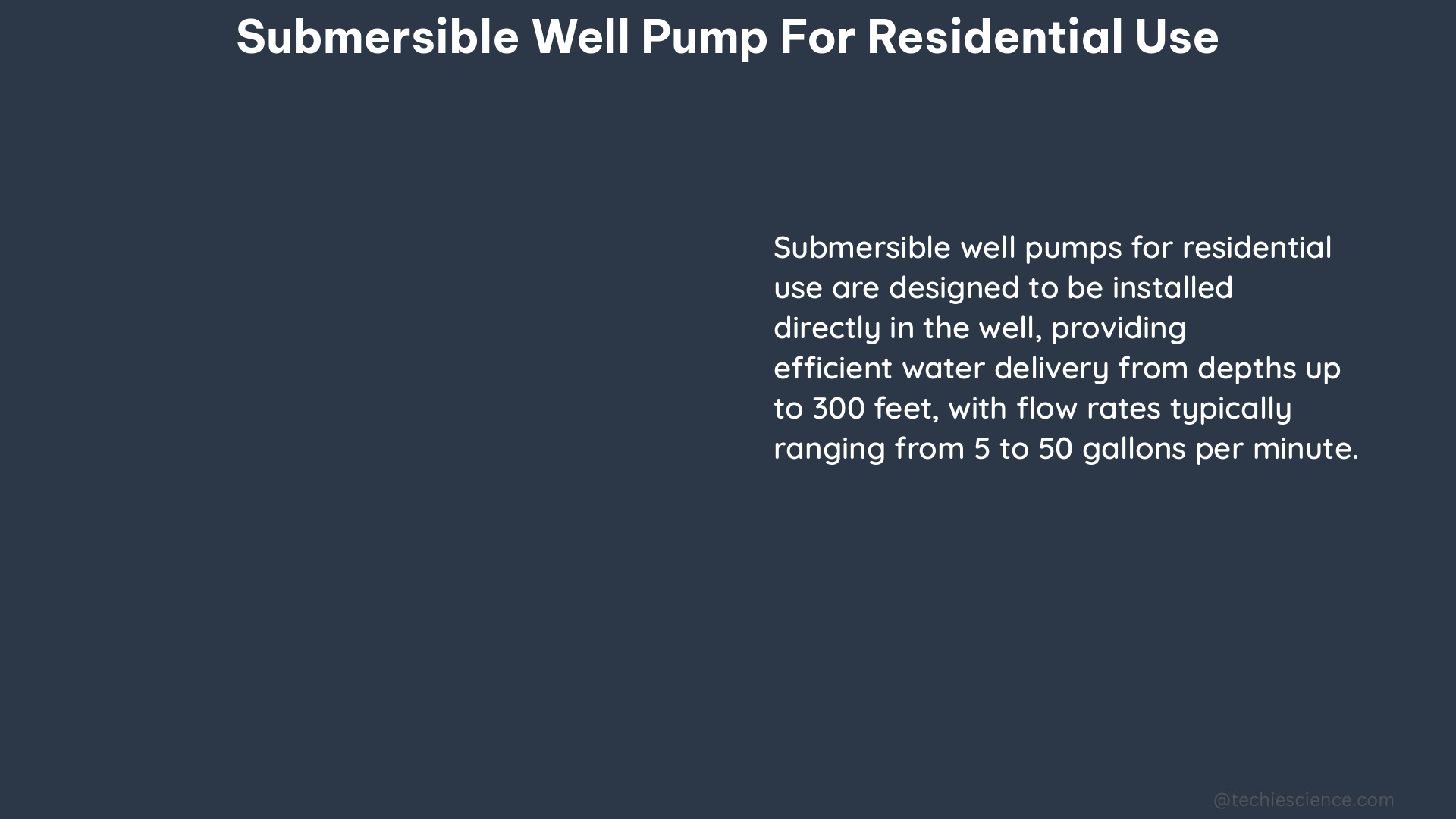Submersible well pumps are the backbone of many residential water supply systems, providing a reliable and efficient way to extract water from underground sources. These specialized pumps are designed to operate submerged in the well, delivering water to the household while ensuring a consistent and controlled flow. In this comprehensive guide, we’ll delve into the technical specifications, measurable data, and DIY considerations to help you select and install the perfect submersible well pump for your residential needs.
Technical Specifications
Horsepower (HP)
The horsepower (HP) rating of a submersible well pump is a crucial factor in determining its power and capacity to lift water. Residential submersible pumps typically range from 1/2 HP to 5 HP, with higher-capacity models available for larger homes or deeper wells. For instance, the Red Jacket 1.5HP pump is suitable for wells up to 120 feet deep, capable of delivering up to 30 GPM at a total dynamic head (TDH) of 400 feet.
Head (Feet)
The head, measured in feet, refers to the vertical distance the pump must lift the water. This includes the well depth, static water level, friction loss in pipes, and pressure requirements at the house. In a typical residential application, the best-case design point might be 400 feet TDH at 15 GPM, while the worst-case scenario could be 600 feet TDH at the same flow rate.
Flow Rate (GPM)
The flow rate, measured in gallons per minute (GPM), is the volume of water the pump can deliver per minute. Residential well pumps typically have a flow rate ranging from 5 to 30 GPM, depending on the well’s capacity and the household’s water demand. In the example provided, the well supplies 15 GPM, which meets the household’s needs.
Measurable Data

Well Depth
The depth of a residential well can vary significantly, ranging from 50 to 500 feet, depending on the geological conditions of the area. Shallower wells typically require lower-capacity pumps, while deeper wells may necessitate higher-capacity models to overcome the increased lift requirements.
Static Water Level
The static water level is the depth to the water table when the pump is not in operation. This level affects the pump’s head requirement, as the pump must lift the water from this depth to the surface.
Friction Loss
Friction loss is the resistance to water flow in pipes due to the friction between the water and the pipe walls. It is measured in feet of head and depends on the pipe’s diameter, length, and flow rate. For example, a 1-inch diameter PVC pipe with a flow rate of 15 GPM can experience a friction loss of approximately 5 feet per 100 feet of pipe length.
Pressure Requirements
The pressure requirements at the house depend on the household’s water demand and the height difference between the well and the house. In the example provided, the house is 50 feet above the well, requiring a pressure of 115 feet (50 PSI) at the house.
DIY Considerations
When installing a submersible well pump for residential use, consider the following DIY steps:
- Measure the Well Depth: Use a tape measure or a well depth sounder to accurately determine the well’s depth, taking care not to damage the well casing.
- Determine the Static Water Level: Measure the static water level by lowering a weighted tape measure into the well until it touches the water surface.
- Calculate Friction Loss: Use a friction loss chart or online calculator to estimate the friction loss in the pipes based on the pipe’s diameter, length, and flow rate. For example, a 1-inch diameter PVC pipe with a flow rate of 15 GPM may experience a friction loss of approximately 5 feet per 100 feet of pipe length.
- Calculate the Total Dynamic Head: Add the well depth, static water level, friction loss, and pressure requirements to calculate the total dynamic head the pump must overcome.
- Select a Suitable Pump: Choose a pump with a horsepower, head, and flow rate that match the calculated total dynamic head and the household’s water demand. Consider factors such as energy efficiency, noise level, and warranty when selecting the pump.
By understanding the technical specifications, measurable data, and DIY considerations, you can confidently select and install the perfect submersible well pump for your residential water supply system. Remember to consult with local authorities and follow all relevant building codes and regulations to ensure a safe and compliant installation.
References:
- Grundfos Ecademy: Pump sizing and installation in domestic groundwater applications
- Practical Machinist: OT – Sizing a water well submersible pump
- Oakville Pump: Choosing the right submersible pump for your water well
- RC West: How to Measure Your Well Pump GPM – YouTube
- EPA: Measurable Goals Guidance for Phase II Small MS4s (PDF)

The lambdageeks.com Core SME Team is a group of experienced subject matter experts from diverse scientific and technical fields including Physics, Chemistry, Technology,Electronics & Electrical Engineering, Automotive, Mechanical Engineering. Our team collaborates to create high-quality, well-researched articles on a wide range of science and technology topics for the lambdageeks.com website.
All Our Senior SME are having more than 7 Years of experience in the respective fields . They are either Working Industry Professionals or assocaited With different Universities. Refer Our Authors Page to get to know About our Core SMEs.